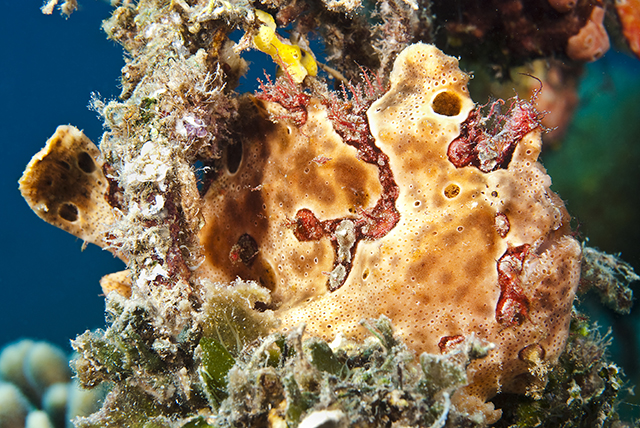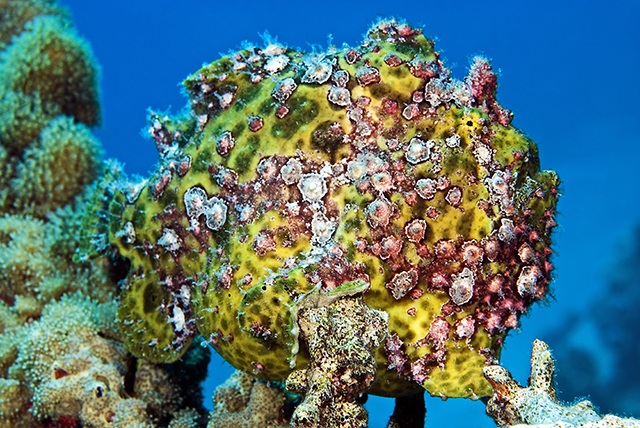News
Resistance Is Futile: Taba’s ‘Alien’ Invasion
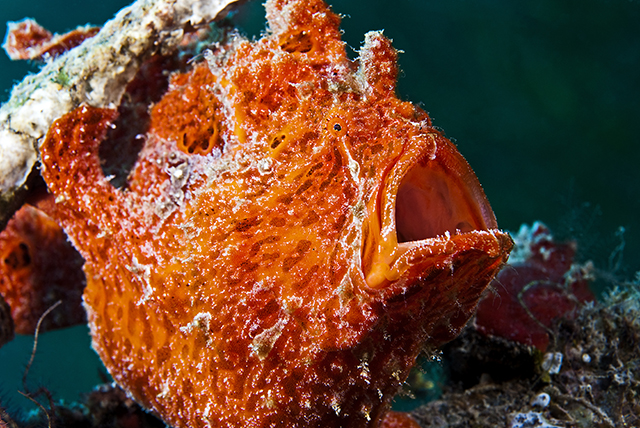
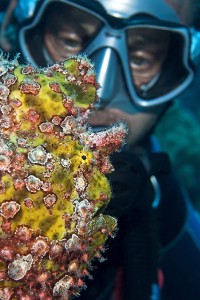
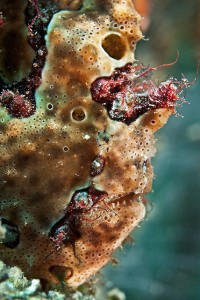 While Taba’s unsuspecting tourists sizzle away in the sunshine, an insatiable predator prepares to strike. This undersea creature lies perfectly camouflaged, armed and extremely deadly. Fish lured into the ambush zone have no escape. Flexible jaws devour in a single, swift gulp. But this strange looking ‘alien’ poses no threat to divers. In fact, there’s no denying it, divers love Frogfish (Antennariidae), and Taba, in northern Egypt, is fast becoming the Red Sea’s top spot for encounters.
While Taba’s unsuspecting tourists sizzle away in the sunshine, an insatiable predator prepares to strike. This undersea creature lies perfectly camouflaged, armed and extremely deadly. Fish lured into the ambush zone have no escape. Flexible jaws devour in a single, swift gulp. But this strange looking ‘alien’ poses no threat to divers. In fact, there’s no denying it, divers love Frogfish (Antennariidae), and Taba, in northern Egypt, is fast becoming the Red Sea’s top spot for encounters.
But what has initiated this increase in ‘alien’ activity, or is it all just a hoax? This definitely had the makings of an X-files mystery? The truth was out there somewhere, so I packed my bags bound for Taba Heights in Egypt. Dan, from Dive Holiday Designers, briefed me en- route: flight ETA – 4 hours; hotel transfer – 45 minutes; accommodation – Intercontinental Hotel;special equipment – Nikon DSLR.
Conditions at Taba are perfect for Froggie spotting. Underwater visibility averages 20 metres throughout the year, currents are virtually non-existent and the majority of dive sites are between 5 – 20 metres. Taba Heights also operates a one boat per site policy so divers aren’t crowding en mass, making the whole experience far more relaxed and enjoyable. A high standard of accommodation and a professionally run dive centre rounded off the facilities perfectly.
There are even some nice shore diving sites where Froggie sightings are virtually guaranteed. At ‘Canyons’ I found 5 different Froggies on a single dive. Huw, the diving manager at Aqua Sport, even told stories of a monster green Froggie that planted itself on his chest during a PADI Advanced Course. This overly friendly Froggie had even been known to sit on a divers head. Huw said ‘It just seems to like divers’.
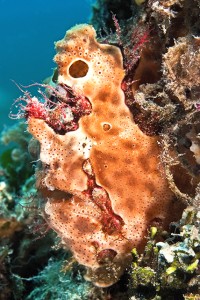
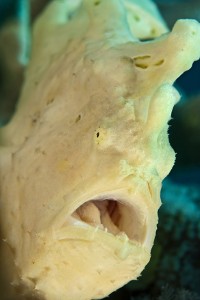 Froggies are extremely ugly looking fish but I’m sure this is all part of their game plan. The masters of stealth can mimic their surroundings by changing colour and texture in a matter of minutes growing lumps and bumps similar to the surface of corals or sponges. Passing fish often don’t see the danger until it’s too late. Divers also have a tough time spotting them, but then, that’s all part of the fun. Red Sea Waterworld’s General Manager had even reported sightings on their house reef. A dark brown Froggie had made its home on an upturned parasol that blew into the sea. My findings were becoming more bizarre each day!
Froggies are extremely ugly looking fish but I’m sure this is all part of their game plan. The masters of stealth can mimic their surroundings by changing colour and texture in a matter of minutes growing lumps and bumps similar to the surface of corals or sponges. Passing fish often don’t see the danger until it’s too late. Divers also have a tough time spotting them, but then, that’s all part of the fun. Red Sea Waterworld’s General Manager had even reported sightings on their house reef. A dark brown Froggie had made its home on an upturned parasol that blew into the sea. My findings were becoming more bizarre each day!
Taba’s coastal waters are home to a number of different species of Froggies. But it’s difficult to tell them apart as there are so many variations in colours, shapes and sizes, even in the same family genus. Worldwide, there are around 46 different species. Sizes vary from a few centimetres up to a giant 40 centimetres. At the Radisson Reef (Shaab Gamila) I found a black 25cm Froggie sitting under a table coral and Katie, my dive buddy, spotted another small dark green 5cm Froggie just a few metres away. Andrew said there were two more Froggies sitting on an old fish trap in the sea grass at 10 metres. We had failed to spot them during our afternoon sortie. Male Froggies tend to be smaller than females and there is no differentiation in colours or patterns.
Glassfish Shoals and pinnacles swathed in Anthias (the little orange fish – pseudanthias squamipinnis) are prime Froggie food. But the voracious feeder isn’t fussy; it will even eat its own kind! Froggies don’t have any teeth. Their prey is sucked in and swallowed whole.
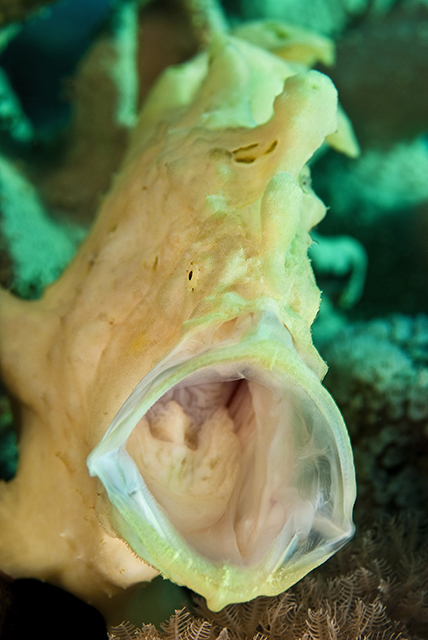 The Glassfish pinnacle at Farun Island is always full of sizeable Froggies. I found three big 20-30cm Froggies camouflaged amongst the coral heads. They are perfect subjects for photographers although it’s not always easy to get a ‘good’ picture. Nine times out of ten they are in a head down position facing towards the reef making it awkward for divers to get a good shot without breaking the fragile corals. Because they are so well camouflaged it’s also difficult to get a picture that looks anything but a lump of coral. The patterned Froggies are the worst. Even with the eye perfectly in focus it is difficult to tell that it’s a fish. I personally think mouth-open shots are the best. As an added bonus Tamer guided us back to the shallows and spotted a bright red 10cm Froggie in just 5 metres. My Froggie count was now nearing double figures in just 4 dives!
The Glassfish pinnacle at Farun Island is always full of sizeable Froggies. I found three big 20-30cm Froggies camouflaged amongst the coral heads. They are perfect subjects for photographers although it’s not always easy to get a ‘good’ picture. Nine times out of ten they are in a head down position facing towards the reef making it awkward for divers to get a good shot without breaking the fragile corals. Because they are so well camouflaged it’s also difficult to get a picture that looks anything but a lump of coral. The patterned Froggies are the worst. Even with the eye perfectly in focus it is difficult to tell that it’s a fish. I personally think mouth-open shots are the best. As an added bonus Tamer guided us back to the shallows and spotted a bright red 10cm Froggie in just 5 metres. My Froggie count was now nearing double figures in just 4 dives!
Froggies have a modified dorsal spine called a lure to attract prey. They use the lure or illiceum just like a fishing rod dangling bait on the end of a line. The shape of the esca or bait can resemble a worm, fish or crab; it will mimic whatever their prey normally eats. Taba’s Froggies all seem to have lures shaped like small fish. They jiggle it about enticing the little Glassfish or Anthias to come closer. This is why Frogfish are also known as Anglerfish.
Froggies aren’t exactly lively creatures. They don’t seem to move very far at all, normally staying in the same place or within a few metres for months on end. This makes the Dive Guides’ jobs nice and easy. They can impress punters with their fish-finding prowess by leading them straight to the Froggie time and time again. At ‘Maxwell’s’ there’s a 20cm purple Froggie that hasn’t moved for more than 2 months. It seems more than happy swaying about on a tube sponge picking off the odd passing fish.
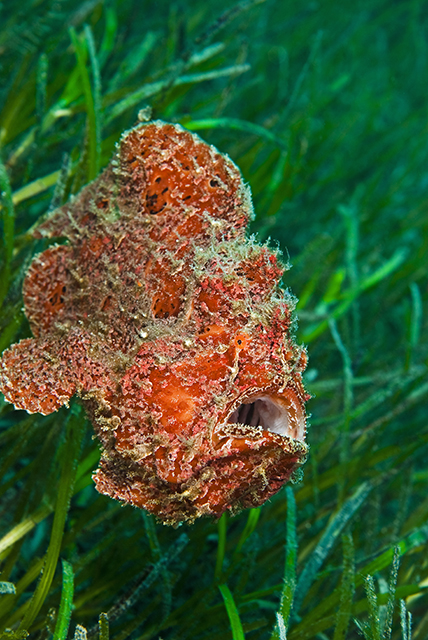 It’s very rare to see Froggies on the move unless they get agitated by divers or over-zealous photographers poking cameras and flashguns too close. They don’t have swim bladders so can’t swim like conventional fish. It’s more like a ‘walk’ using their modified pectoral fins as legs. For more rapid movement they use a form of jet propulsion, gulping in water and forcing it out from a small opening behind the gills. This produces forward thrust along the seabed.
It’s very rare to see Froggies on the move unless they get agitated by divers or over-zealous photographers poking cameras and flashguns too close. They don’t have swim bladders so can’t swim like conventional fish. It’s more like a ‘walk’ using their modified pectoral fins as legs. For more rapid movement they use a form of jet propulsion, gulping in water and forcing it out from a small opening behind the gills. This produces forward thrust along the seabed.
My week long investigation was reaching an end. Most of Taba’s 17 dive sites had at least one or two resident Froggies. Although when I returned to Taba 2 months later I found that the big Farun Island Froggies had disappeared. All I could find was 2 bright green medium sized Froggies. I had no idea where they had gone or why they had moved. There was some talk that they had ended up in an Aquarium, but this was just a rumour. Maybe they had disappeared into the deep blue to reproduce? Not much is known about their mating habits other than it normally occurs at night. Unfortunately night diving is not permitted at Taba so no one can check out this theory.
This X-files mystery had revealed some startling facts. Taba’s Froggie army is definitely growing fast. I clocked up more than a dozen sightings in just 5 days, some with the most bizarre colours and patterns. There seems to be no set season and they can be spotted throughout the year. Divers should arm themselves with an underwater camera as soon as possible. The ‘alien’ invasion has begun – resistance is futile!
Blogs
Northern Red Sea Reefs and Wrecks Trip Report, Part 2: Wall to Wall Wrecks

Jake Davies boards Ghazala Explorer for an unforgettable Red Sea diving experience…
The second day’s diving was a day full of wreck diving at Abu Nuhas, which included the Chrisoula K, Carnatic, and Ghiannis D. The first dive of the day was onto the Chrisoula K, also known as the wreck of tiles. The 98m vessel remains largely intact where she was loaded with tiles which can be seen throughout the hold. The stern sits at 26m and the bow just below the surface. One of the highlights of the wreck is heading inside and seeing the workroom where the machinery used for cutting the tiles are perfectly intact. The bow provided some relaxing scenery as the bright sunlight highlighted the colours of the soft coral reef and the many reef fish.

Following breakfast, we then headed to the next wreck, which was the Carnatic. The Carnatic is an 89.9m sail steamer vessel that was built in Britain back in 1862. She ran aground on the reef back in 1869 and remains at 27m. At the time, she was carrying a range of items, including 40,000 sterling in gold. An impressive wreck where much of the superstructure remains, and the two large masts lay on the seafloor. The wooden ribs of the hull provide structures for lots of soft corals, and into the stern section, the light beams through, bouncing off the large shoals of glass fish that can be found using the structure as shelter from the larger predators that are found outside of the wreck.

The final wreck at Abu Nuhas was the Ghiannis D, originally called ‘Shoyo Maru,’ which was 99.5m long and built in Japan back in 1969 before becoming a Greek-registered cargo ship in 1980. The ship then ran aground on the reef on April 19th, 1983, and now sits at the bottom at a depth of 27m. Heading down the line, the stern of the ship remains in good condition compared to the rest of the hull. The highlight of the wreck, though, is heading into the stern section and down the flights of stairs to enter the engine room, which remains in good condition and is definitely worth exploring. After exploring the interior section of the ship, we then headed over to see the rest of the superstructure, where it’s particularly interesting to see the large table corals that have grown at the bow relatively quickly considering the date the ship sank. After surfacing and enjoying some afternoon snacks, we made sure everything was strapped down and secured as we would be heading north and crossing the Gulf of Suez, where the winds were still creating plenty of chop.

The next morning, it was a short hop to Ras Mohammed Nature Reserve for the next couple of days of diving. The 6am wake-up call came along with the briefing for the first site we would be diving, which was Shark & Yolanda. The low current conditions allowed us to start the dive at Anemone City, where we would drift along the steep, coral-filled wall. These dives involved drifts, as mooring in Ras Mohammed wasn’t allowed to protect the reefs. As a dive site, Shark & Yolanda is well-known and historically had a lot of sharks, but unfortunately not so many in recent years, especially not so early in the season. However, there was always a chance when looking out into the blue.

The gentle drift took us along the steep walls of the site, with plenty of anemone fish to be seen and a huge variety of corals. It wasn’t long into the dive before we were accompanied by a hawksbill turtle, who drifted with us between the two atolls before parting ways. Between the two reefs, the shallow patch with parts of coral heads surrounded by sand provided the chance to see a few blue-spotted stingrays that were mainly resting underneath the corals and are always a pleasure to see. With this being the morning dive, the early sunlight lit up the walls, providing tranquil moments. Looking out into the blue, there was very little to be seen, but a small shoal of batfish shimmering underneath the sunlight was a moment to capture as we watched them swim by as they watched us.

Towards the end of the dive, we stopped at the wreck of the Jolanda where the seafloor was scattered with toilets from the containers it was carrying. This provided a unique site to make a safety stop, which was also accompanied by a large barracuda slowly swimming by, along with a hawksbill turtle calmly swimming over the reef as the sun rays danced in the distance.
For the next dive, we headed north to the Strait of Tiran to explore the reefs situated between Tiran Island and Sharm El Sheik, which were named after the British divers who had found them. We started on Jackson before heading to Gordons Reef, where we also did the night dive. All the atolls at these sites provided stunning, bustling coral reefs close to the surface and steep walls to swim along, which always provided the opportunity to keep an eye out for some of the larger species that can be seen in the blue. Midwater around Jackson Reef was filled with red-toothed triggerfish and shoals of banner fish, which at times were so dense that you couldn’t see into the blue. Moments went by peacefully as we enjoyed the slow drift above the reef, watching these shoals swim around under the mid-afternoon sun.

The night dive at Gordon’s Reef was mainly among the stacks of corals surrounded by sand, which was great to explore under the darkness. After some time circling the corals, we came across what we were really hoping to find, and that was an octopus hunting on the reef. We spent the majority of the dive just watching it crawl among the reef, blending into its changing surroundings through changes in colour and skin texture. It’s always so fascinating and captivating to watch these incredibly intelligent animals, in awe of their ability to carry out these physical changes to perfectly blend into the reef. Before we knew it, it was time to head back to the boat to enjoy a well-deserved tasty dinner prepared by the talented chefs onboard.
Check in for the 3rd and final part of this series from Jake tomorrow!
To find out more about the Northern Red Sea reef and wrecks itineraries aboard Ghazala Explorer, or to book, contact Scuba Travel now:
Email: dive@scubatravel.com
Tel: +44 (0)1483 411590
Photos: Jake Davies / Avalon.Red
Marine Life & Conservation
Double Bubble for Basking Sharks

 The Shark Trust is excited to announce that, for two more days only, all donations, large or small, will be doubled in the Big Give Green Match Fund!
The Shark Trust is excited to announce that, for two more days only, all donations, large or small, will be doubled in the Big Give Green Match Fund!
Donate to Basking in Nature: Sighting Giants
The Shark Trust is hoping to raise £10k which will be doubled to £20k. This will go towards Basking in Nature: Sighting Giants. And they need YOUR help to reach they’re goal.
The Shark Trust’s citizen science project is to monitor and assess basking sharks through sightings; encouraging data collection, community engagement, and promoting nature accessibility. This initiative aims to enhance health and wellbeing by fostering a deeper connection with British Sharks.
Campaign Aims
- Increase citizen science reporting of Basking Sharks and other shark sightings to help inform shark and ray conservation.
- Provide educational talks about the diverse range of sharks and rays in British waters and accessible identification guides!
- Create engaging and fun information panels on how to ID the amazing sharks and rays we have on our doorstep! These can be used on coastal paths around the Southwest. With activities and information on how you can make a difference for sharks and rays!
- Promote mental wellbeing through increasing time in nature and discovering the wonders beneath the waves!
Donate, and double your impact. Click Here
-

 News3 months ago
News3 months agoHone your underwater photography skills with Alphamarine Photography at Red Sea Diving Safari in March
-

 News3 months ago
News3 months agoCapturing Critters in Lembeh Underwater Photography Workshop 2024: Event Roundup
-

 Marine Life & Conservation Blogs2 months ago
Marine Life & Conservation Blogs2 months agoCreature Feature: Swell Sharks
-

 Blogs2 months ago
Blogs2 months agoMurex Resorts: Passport to Paradise!
-

 Blogs2 months ago
Blogs2 months agoDiver Discovering Whale Skeletons Beneath Ice Judged World’s Best Underwater Photograph
-

 Gear Reviews2 months ago
Gear Reviews2 months agoGear Review: Oceanic+ Dive Housing for iPhone
-

 Marine Life & Conservation2 months ago
Marine Life & Conservation2 months agoSave the Manatee Club launches brand new webcams at Silver Springs State Park, Florida
-

 News3 months ago
News3 months agoWorld’s Best Underwater Photographers Unveil Breathtaking Images at World Shootout 2023


